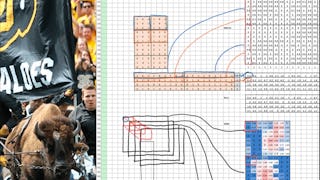Step into the frontier of artificial intelligence with this advanced course designed to explore the latest models powering visual and multimodal intelligence. From foundational mathematical tools to state-of-the-art architectures, you'll gain the skills to understand and build systems that interpret images, text, and more—just like today’s leading AI models.


Modern AI Models for Vision and Multimodal Understanding
本课程是 Computer Vision 专项课程 的一部分

位教师:Tom Yeh
包含在 中
您将学到什么
Apply Nonlinear Support Vector Machines (NSVMs) and Fourier transforms to analyze and process visual data.
Use probabilistic reasoning and implement Recurrent Neural Networks (RNNs) to model temporal sequences and contextual dependencies in visual data.
Explain the principles of transformer architectures and how Vision Transformers (ViT) perform image classification and visual understanding tasks.
Implement CLIP for multimodal learning, and utilize diffusion models to generate high-fidelity images.
您将获得的技能
要了解的详细信息

添加到您的领英档案
August 2025
19 项作业
了解顶级公司的员工如何掌握热门技能

积累特定领域的专业知识
- 向行业专家学习新概念
- 获得对主题或工具的基础理解
- 通过实践项目培养工作相关技能
- 获得可共享的职业证书

该课程共有4个模块
Welcome to Modern AI Models for Vision and Multimodal Understanding, the third course in the Computer Vision specialization. In this first module, you’ll explore foundational mathematical tools used in modern AI models for vision and multimodal understanding. You’ll begin with Support Vector Machines (SVMs), learning how linear and radial basis function (RBF) kernels define decision boundaries and how support vectors influence classification. Then, you’ll dive into the Fourier Transform, starting with 1D signals and progressing to 2D applications. You’ll learn how to move between time/spatial and frequency domains using the Discrete Fourier Transform (DFT) and its inverse, and how these transformations reveal patterns and structures in data. By the end of this module, you’ll understand how SVMs and Fourier analysis contribute to feature extraction, signal decomposition, and model interpretability in AI systems.
涵盖的内容
14个视频7篇阅读材料5个作业
This module invites you to explore how probability theory and sequential modeling power modern AI systems. You’ll begin by examining how conditional and joint probabilities shape predictions in language and image models, and how the chain rule enables structured generative processes. Then, you’ll transition to recurrent neural networks (RNNs), learning how they handle sequential data through hidden states and feedback loops. You’ll compare RNNs to feedforward models, explore architectures like one-to-many and sequence-to-sequence, and address challenges like vanishing gradients. By the end, you’ll understand how probabilistic reasoning and temporal modeling combine to support tasks ranging from text generation to autoregressive image synthesis.
涵盖的内容
15个视频2篇阅读材料5个作业
This module explores how attention-based architectures have reshaped the landscape of deep learning for both language and vision. You’ll begin by unpacking the mechanics of the Transformer, including self-attention, multi-head attention, and the encoder-decoder structure that enables parallel sequence modeling. Then, you’ll transition to Vision Transformers (ViTs), where images are tokenized and processed using the same principles that revolutionized NLP. Along the way, you’ll examine how normalization, positional encoding, and projection layers contribute to model performance. By the end, you’ll understand how Transformers and ViTs unify sequence and spatial reasoning in modern AI systems.
涵盖的内容
15个视频2篇阅读材料5个作业
In this module, you’ll explore two transformative approaches in multimodal and generative AI. First, you’ll dive into CLIP, a model that learns a shared embedding space for images and text using contrastive pre-training. You’ll see how CLIP enables zero-shot classification by comparing image embeddings to textual descriptions, without needing labeled training data. Then, you’ll shift to diffusion models, which generate images through a gradual denoising process. You’ll learn how noise prediction, time conditioning, and reverse diffusion combine to produce high-quality samples. This module highlights how foundational models can bridge modalities and synthesize data with remarkable flexibility.
涵盖的内容
11个视频2篇阅读材料4个作业
获得职业证书
将此证书添加到您的 LinkedIn 个人资料、简历或履历中。在社交媒体和绩效考核中分享。
攻读学位
课程 是 University of Colorado Boulder提供的以下学位课程的一部分。如果您被录取并注册,您已完成的课程可计入您的学位学习,您的学习进度也可随之转移。
位教师

从 Algorithms 浏览更多内容
 状态:免费试用
状态:免费试用University of Colorado Boulder
 状态:预览
状态:预览University of Colorado Boulder
人们为什么选择 Coursera 来帮助自己实现职业发展




常见问题
To access the course materials, assignments and to earn a Certificate, you will need to purchase the Certificate experience when you enroll in a course. You can try a Free Trial instead, or apply for Financial Aid. The course may offer 'Full Course, No Certificate' instead. This option lets you see all course materials, submit required assessments, and get a final grade. This also means that you will not be able to purchase a Certificate experience.
When you enroll in the course, you get access to all of the courses in the Specialization, and you earn a certificate when you complete the work. Your electronic Certificate will be added to your Accomplishments page - from there, you can print your Certificate or add it to your LinkedIn profile.
Yes. In select learning programs, you can apply for financial aid or a scholarship if you can’t afford the enrollment fee. If fin aid or scholarship is available for your learning program selection, you’ll find a link to apply on the description page.
更多问题
提供助学金,





